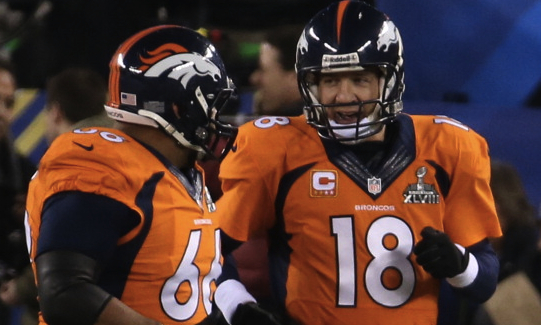As the Seattle Seahawks were holding their official Super Bowl Victory celebration this morning I was celebrating my own victoy.
Super Bowl 2014 proved that I am not a Monday Morning Quarterback.
I am a Sunday Morning Quarterback.
On the eve of the Super Bowl I posted this piece explaining why I thought the most important position in football is the Center – in part because of the quantity of information he must absorb and the speed with which he must process it.
I had declared Sunday “Center Awareness Day.”
I suggested keeping your eye on the Center – at least for a few plays.
The first snap of the game made my case.
But I didn’t feel happiness.
I felt empathy. And curiosity.
I wanted to know why Denver’s Center, Manny Ramirez, overshot Peyton Manning on that very first play – a mistake that seemed to set the tone of the game.
I found the answer at midnight here on NFL.COM.
Manning described the bad snap as a “cadence issue.”
Some serious football fans know how the term “cadence” applies to a snap.
But it was news to me. I just know cadence as a musical term for rhythmic pattern.
Now I know, the rhythmic patterns of the Quarterback’s voice, not simply the words, plays a role in the timing of the snap.
“We were using a snap count on the play, but due to the noise, no one could hear me,” Manning said. “So really I was walking up to the line of scrimmage to make a change and try get us on the same page. The ball was snapped. Really just an overall, nobody’s fault.”
Ramirez, taking responsibility, the moments before the snap.
“It was real loud. We were trying to go on the cadence. I thought I heard him. I didn’t,” Ramirez explained. “He was actually walking up to me because he had already said the cadence, and I snapped it.”
You can see for yourself – in the video on this nfl.com link, how QB Manning is indeed walking up to Center Ramirez as Ramirez is snapping the ball to where Manning had been a moment earlier.
That phrase from Ramirez – he thought he heard the cadence, but he didn’t –sounds like something one musician would say to another.
So, in an effort for deeper understanding, I asked around for a musician to contact. I was put in touch with Will Turpin, the bass player who keeps the cadence for the band Collective Soul – whose music you can sample here.
“My experience with cadence,” Turpin tells me, “goes back to my earliest music training … on the drum line at Stockbridge High School in metro Atlanta. … Rhythmic cadences were everything in terms of getting 17 people in a drum line to play together.” The section leader is responsible for establishing the cadence of a drum line. Turpin was a section leader.
“That’s where I first understood how to play tight and together.” You get the parallels.
“Bass,” says Turpin, “is the absolute conjunction between the drummer who is straight rhythm and the cadence of the rest of the band.”
It sounds like Turpin and the band’s drummer, Shane, have the kind of relationship a Quarterback and his Center must have. “We marched side by side on that Stockbridge High drum line for four years” Turpin tells me. All that time together created what Turpin calls an “unspoken language” that helps Collective Soul’s sound so tight.
To communicate cadence on a football field though – requires a loudly spoken and constantly shifting language – one that can be heard above the noise of the stadium crowd.
And here’s another big difference. Quarterbacks use cadence not to create an offensive rhythm, but to prevent the defense from getting into its own rhythm.
So one play the ball may be hiked on the second hut – “hut hut.”
Next play it may be Hut HUT hut. Different cadence. Different Snap. Keeps the defense guessing. And challenges the mental processing abilities of the best Centers.
Imagine how difficult it is – as a Center – to keep straight in your head when to snap the ball when the cadence is changing through the game – even changing in the 30 or so seconds between the huddle and the snap.
So now that I know what cadence means in football (and music), I have even greater respect for the Center than I had when I declared Sunday “Center Awareness Day.”
I have even greater respect for the mental processing speed of the Center.
And I have even greater respect for Denver’s #66, Manny Ramirez, and his resilience.
Because, after that first snap, based on what I could see, Denver didn’t have another bad snap the rest of the game.
The Broncos offense never did hit a stride. Their offensive cadence never interfered with the rhythm of the Seahawks defense.
But Manny Ramirez bounced back.
And Peyton Manning already is trying to figure out how to bounce back for the future.
“Hopefully,” Manning told reporters last night after the loss, “we can use this to fuel us this off season and in the next season as well.“
“You have to find a way to deal with it and process it,” said Manning. “…It takes some time.”
The processing speed of a Center and a Quarterback during a football game is dazzling.
But some things – like the loss of a game of a lifetime – take longer to process. A slower cadence.
That’s something we all have to accept in life.

